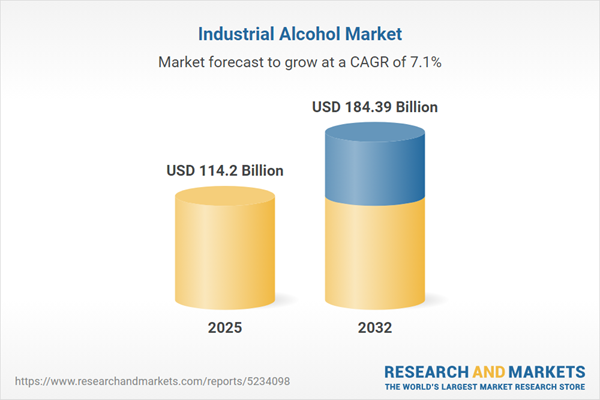Speak directly to the analyst to clarify any post sales queries you may have.
The industrial alcohol market is experiencing significant transformation, underpinned by advances in production technologies, expanding end-use applications, and evolving regulatory pressures. For senior leaders, understanding these dynamics is essential for informed strategy in this global, multi-sector industry.
Market Snapshot: Industrial Alcohol Market Growth and Outlook
The Industrial Alcohol Market grew from USD 106.78 billion in 2024 to USD 114.20 billion in 2025. It is expected to achieve sustained expansion at a CAGR of 7.06%, reaching USD 184.39 billion by 2032.
Scope & Segmentation
- Types: Butanol, Ethanol, Isopropanol, Methanol.
- Applications: Chemical Intermediates, Food & Beverage, Fuel, Personal Care, Pharmaceutical & Cosmetics, Solvents.
- Production Processes: Fermentation (using Beets, Corn, Molasses, Sugarcane), Synthetic methods (Coal Gasification, Steam Methane Reforming).
- Purity Levels: Food Grade, Fuel Grade, Industrial Grade, Pharma Grade.
- Distribution Channels: Direct, Indirect.
- Regions: North America (United States, Canada, Mexico), Latin America (Brazil, Argentina, Chile, Colombia, Peru), Europe (United Kingdom, Germany, France, Russia, Italy, Spain, Netherlands, Sweden, Poland, Switzerland), Middle East (United Arab Emirates, Saudi Arabia, Qatar, Turkey, Israel), Africa (South Africa, Nigeria, Egypt, Kenya), Asia-Pacific (China, India, Japan, Australia, South Korea, Indonesia, Thailand, Malaysia, Singapore, Taiwan).
- Covered Companies: Archer Daniels Midland Company, Cargill Incorporated, POET LLC, Green Plains Inc., Valero Energy Corporation, Grain Processing Corporation, Tereos S.A., Cristal Union, CropEnergies AG, Global Bio-chem Technology Group Company Limited.
Key Takeaways
- Innovation in fermentation and synthetic pathways is improving feedstock flexibility and yield, directly influencing market competitiveness for senior decision-makers.
- Expanding end-use applications in pharmaceuticals, personal care, and fuels are reshaping demand profiles, driving higher standards for quality and purity.
- Shifts toward bio-based feedstocks and circular economy practices are accelerating, prompted by regulatory frameworks and sustainability targets.
- Geopolitical and logistical risks highlight the urgency for localized production and diversification of supply chains, supported by digital supply chain solutions.
- Partnerships across feedstock providers, technology vendors, and end-users are enabling more agile and resilient business strategies.
Tariff Impact: U.S. Trade Policy Shifts
Upcoming tariff adjustments in the United States will introduce both challenges and opportunities across the industrial alcohol value chain. Heightened duties on feedstock and derivatives may reduce international supplier competitiveness and prompt export realignments. Consequently, domestic producers have the potential for margin improvements, while end-users may need to reassess sourcing strategies. Strategic investment in regional production and proactive engagement with trade policy will be key for navigating these changes and ensuring reliable supply.
Methodology & Data Sources
This analysis employs a multimethod research protocol. It integrates secondary sources such as peer-reviewed journals, regulatory documents, and corporate reports with in-depth interviews of senior executives and technical experts. Quantitative demand modeling, scenario analysis, and cross-verification of multiple datasets underpin the reliability and depth of market insights.
Why This Report Matters
- Enables executive teams to calibrate investment and operational strategies by mapping production, supply, and demand shifts across global regions.
- Supports leaders in benchmarking against competitors, understanding key technology adoption patterns, and identifying high-potential segments.
- Informs proactive engagement with policy and regulatory changes, helping reduce exposure to trade or compliance risks.
Conclusion
Sustained growth in the industrial alcohol sector will hinge on a balanced approach to innovation, operational excellence, and stakeholder collaboration. Senior decision-makers who align strategies with these dynamics can capture new opportunities in an evolving global landscape.
Additional Product Information:
- Purchase of this report includes 1 year online access with quarterly updates.
- This report can be updated on request. Please contact our Customer Experience team using the Ask a Question widget on our website.
Table of Contents
3. Executive Summary
4. Market Overview
7. Cumulative Impact of Artificial Intelligence 2025
List of Figures
Samples

LOADING...
Companies Mentioned
The key companies profiled in this Industrial Alcohol market report include:- Archer Daniels Midland Company
- Cargill, Incorporated
- POET, LLC
- Green Plains Inc.
- Valero Energy Corporation
- Grain Processing Corporation
- Tereos S.A.
- Cristal Union
- CropEnergies AG
- Global Bio-chem Technology Group Company Limited
Table Information
| Report Attribute | Details |
|---|---|
| No. of Pages | 186 |
| Published | October 2025 |
| Forecast Period | 2025 - 2032 |
| Estimated Market Value ( USD | $ 114.2 Billion |
| Forecasted Market Value ( USD | $ 184.39 Billion |
| Compound Annual Growth Rate | 7.0% |
| Regions Covered | Global |
| No. of Companies Mentioned | 11 |









